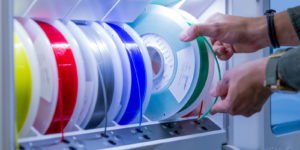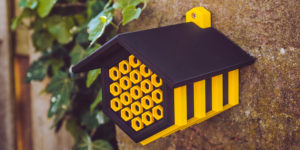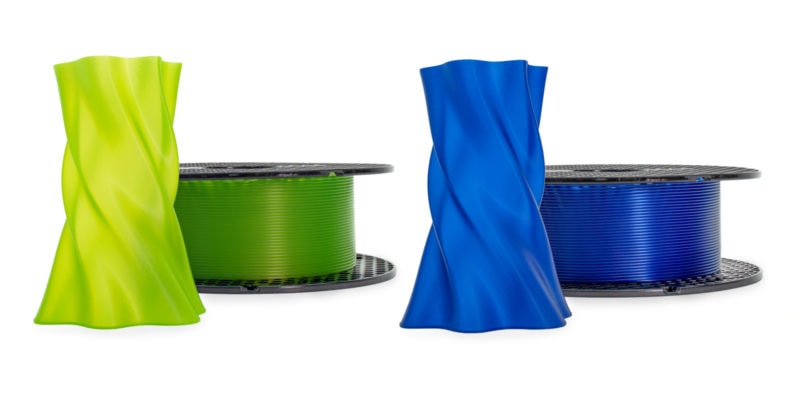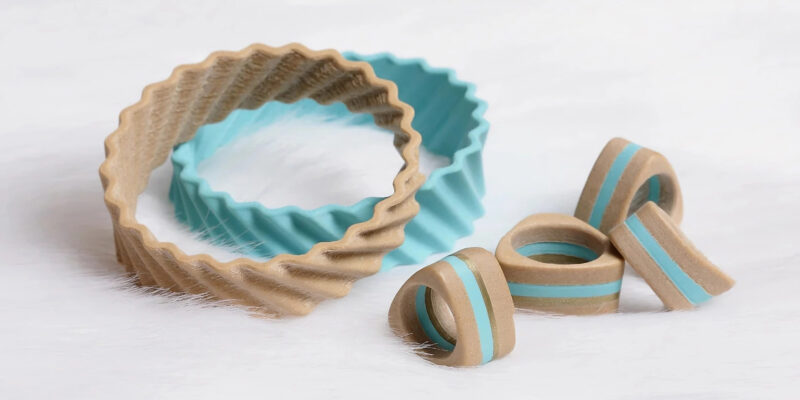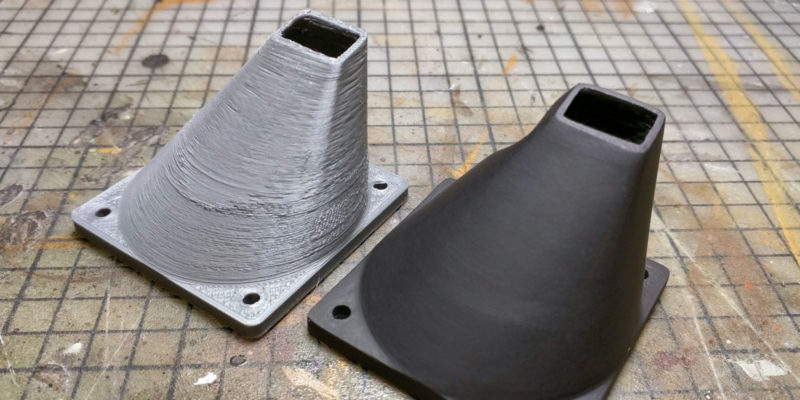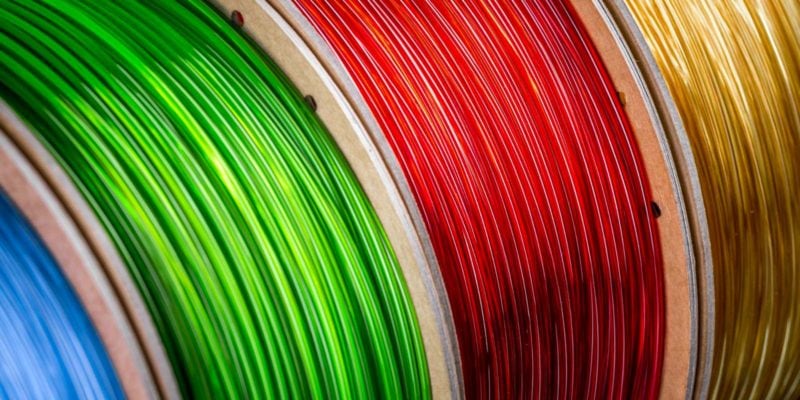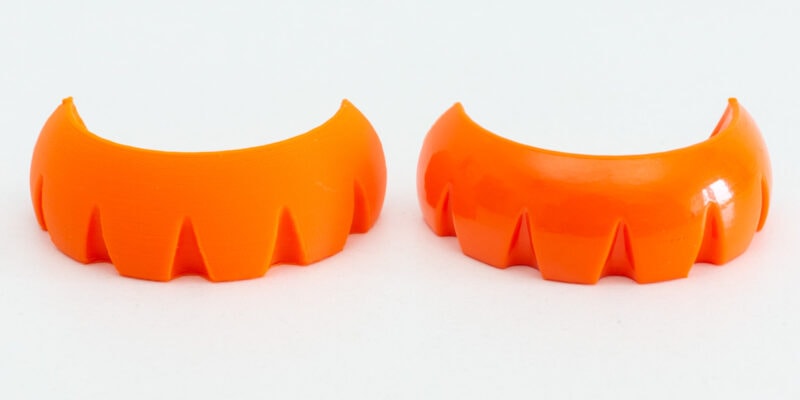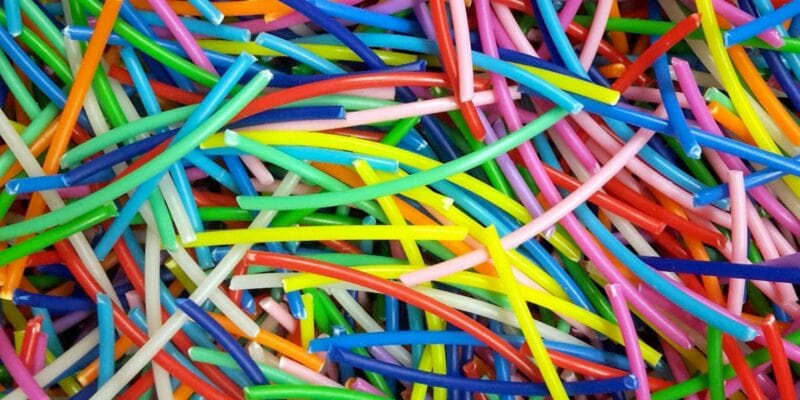If you’re familiar with 3D printing, you’ve probably heard of the thermoplastics PLA and PETG at least once or twice. As two common materials used in the 3D printing process, both PLA and PETG have advantages and disadvantages in certain situations.
Ready to find out more? In this article, we’ll take you through the different physical properties of PETG vs PLA, which projects are best suited to each, the pros and cons of their filaments, and what specifications your 3D printer needs to use them.
What are PETG and PLA?
PLA stands for polylactic acid and is a thermoplastic popular for 3D printing. It is a biodegradable bioplastic made from organic plant matter (usually corn starch or sugar cane). It is often used to make plastic cups and cutlery, plastic shrink packaging, cling wrap, and removable parts for medical devices.
PET (polyethylene terephthalate) is one of the most common types of plastic. It is what most plastic bottles are made from. You can also find it used for things like Tupperware and takeout containers. PET is not a suitable material to use with 3D printing since it is very fragile and brittle, so manufacturers add glycol (hence the G in PETG) to make the resulting filament more durable and elastic.

PETG vs PLA: How Do They Compare?
At a Glance
| PLA | PETG | |
|---|---|---|
| Nozzle temperature | 190-220C | 210-250C |
| Bed temperature | 60-70C (optional) | 70-80C |
| Enclosure required |
No | Yes |
| Strength | Poor | Good tensile and impact |
| Flexibility | Poor – brittle | Good |
| Fumes | Little to no odor | Some fumes |
| Heat resistance | Poor | Good |
| Glass transition temp | 60C | 80C |
| Shrinkage | Low | Low |
| Printability | Good | Okay |
| Approx. price per kg | $20 | $30 |
Strength
PETG plastic has a higher tensile strength than PLA, is more impact resistant, and can stretch farther before breaking. PLA is fairly rigid and brittle, so while its tensile strength is higher than other filaments like ABS, PETG is a much better option for projects requiring durability.
Material Flexibility
Between the two materials, PETG filament has greater flexibility than PLA. Whereas PLA is brittle and tends to break or chip on impact, PETG is more likely to bounce slightly and avoid damage when dropped.
Dimensional Accuracy
Dimensional accuracy (how closely the finished object matches the 3D model in shape and size) is important when printing things like industrial parts, but, depending on your requirements, it can be difficult to achieve with fused deposition modeling (FDM) printing. PLA usually has good dimensional accuracies thanks to its low print temperature and small shrink rate.
Since PETG is a high-temperature filament, it is slightly more prone to warping and shrinkage than PLA. Therefore, between the two materials, PLA is better for printing things that need to match the exact dimensions of their designs.
If you plan to print things that need good dimensional accuracy, using resin 3D printing may be better than printing with FDM. Since resin printing uses UV light instead of heat, it offers more precise results than FDM printing in terms of both size and shape. The strength of 3D printer resin is fairly limited, however, so you will have to further compare resin with filament to check whether this 3D printing method suits your needs.
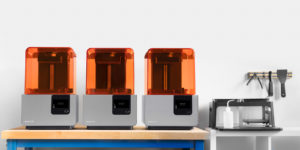
Warping
PETG tends to warp more than PLA during 3D printing. Like ABS and other high-temperature filaments, PETG can warp or crack if the temperature drops during printing. It does not do it to the same degree as other materials like ABS, but it is still noticeably more so than PLA.

Print Temperature
The biggest difference between PLA and PETG filament is their required print temperatures. Whereas PLA easily prints at low temperatures, PETG requires higher nozzle temps, a heated bed, and ideally a 3D printer enclosure to print properly.
You can print with PLA filament at a nozzle temperature of about 200C. While you can use a heated bed with PLA for better first-layer adhesion, it is not required. These low-temperature tolerances mean finished PLA 3D prints need to stay below about 50C to avoid softening or deformation.
PETG requires temperatures and conditions closer to ABS. PETG prints with a nozzle temp of about 230C. It also needs a warm environment to keep print temperatures consistent. Without this, your PETG 3D prints are likely to warp. For that reason, an enclosed 3D printer is often listed as a requirement to print successfully with PETG.
PETG’s higher printing temperature means it can withstand higher environmental temps after printing. Finished PETG 3D prints won’t start to warp or deform from heat until they reach about 70C.
Print Speed
Both PETG and PLA print around the same speeds. However, you may notice more stringing and oozing with PETG than PLA. If this is the case, it is best to modify your retraction settings to get better results. Using a temperature tower to calibrate your printing temperatures will help as well, but we have a whole article on PETG stringing you can use for more solutions.
You can learn more about the best settings to use with PLA in our guide to 3D printing with PLA.
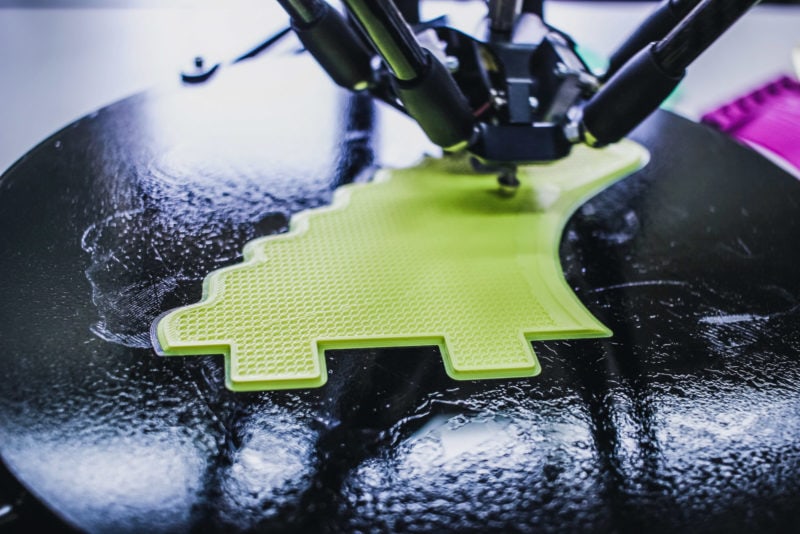
Fumes
PLA produces very few odors or fumes while 3D printing and is considered the safest filament option in that regard. You may notice a slightly sweet smell coming from your printer during printing, but studies have shown that PLA only emits generally harmless polylactic acid particles into the air.
Even the best PETG filament produces a bit more fumes and air particles than PLA but still significantly less than other filaments like ABS. However, since PETG already needs an enclosure to 3D print well, it is easy to vent the fumes from the building and it is always a good idea to do so.
Storage
PETG filament is much easier to store than PLA since it is not as affected by environmental factors. PLA absorbs moisture easily, so ideally it needs to be stored in air-tight containers (preferably with silica gel packets) when not in use. If it ever absorbs too much moisture, it should first be dried in a special filament drying device or a simple dehydrator before using it again.
PLA breaks down in water, so if your PLA filament encounters moisture in the air, its quality quickly degrades. Moisture makes PLA more brittle, so your filament will be more prone to snapping if stored improperly. It will also sizzle and bubble during printing as the heat from the nozzle evaporates the moisture.
PETG, on the other hand, is highly resistant to water, so it does not need to be stored as carefully. Keeping it in an air-tight container between uses is still a good practice, but you likely won’t need to dry out the filament as you do with PLA.
If either your PLA or PETG absorbs too much moisture, you can use a filament dry box to restore it to its original state.
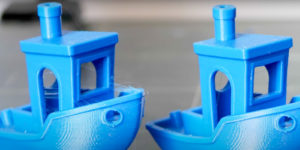
Post-Processing
In terms of post-processing, PLA is the clear winner. PLA filaments have higher print quality, sand easily, take fillers and epoxy coats well, and have good adherence with most paints. Gluing PLA is not the easiest, but it can be achieved with the right products.
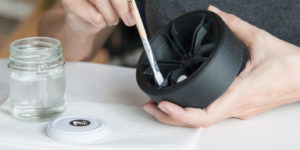
PETG is nearly impossible to glue, so it is not suited to projects that will need to be printed into multiple pieces and assembled. If you are looking to 3D print a helmet, 3D print armor, or other large cosplay items that require gluing during assembly, PETG is not a good choice.
While smoothing PLA gives the final 3D print a shine, PETG scratches more easily. These scratches are hard, if not impossible, to remove later. PETG also does not handle paint or fillers well, so it is best to print items in the desired color when working with PETG.
Biodegradability
PLA is technically biodegradable, though it usually takes some time to fully break down. The process can be sped up at a commercial composting facility, or the plastic can be recycled for further use. PETG is recyclable, but it is not biodegradable or compostable like PLA.
Filament Price
Both PLA and PETG tend to be relatively low-cost filament options. While PLA is slightly cheaper, the difference is usually too negligible to be a real factor in deciding which material to use.
Best Applications for PLA and PETG
In comparing PLA vs PETG, both have their advantages and disadvantages that make them a suitable filament choice for some 3D printing projects and a poor choice for others. Let’s take a look at some of the things to consider when choosing between the two plastics for a project.
Temperature
If your finished project is going to be exposed to high temperatures, such as being outside in the sun or a hot car, PETG is a better option than PLA. Since PLA has such a low tolerance for heat, it warps and softens in those conditions.
Moisture
Another thing to consider with using PLA vs PETG is if your final project will be in direct contact with water or a high humidity environment. Since PLA breaks down in water, your printed cups, vases, etc. will quickly degrade and leak if printed with PLA filament.
PETG is resistant to water, which is to be expected with its widespread use as a material for plastic bottles for water and other beverages. It is the ideal choice for things like cups, vases, or hose fittings and attachments and should be used over PLA.
Color
PETG doesn’t hold color as well as PLA, so keeping a consistent color between filament batches is difficult. Anything requiring long-term color consistency should be made with PLA. However, if you need your project to be transparent, PETG is the best option.
Many of the top brands for PLA filament have an excellent selection of available colors. If you’re not sure which filament option to choose, check out our guide to the best PLA filament brands available right now.

Strength
Since PETG has higher tensile strength, flexibility, heat resistance, and moisture resistance, PETG is a great option for projects requiring good durability. Industrial parts, tools, and cases are all excellent projects in which to use PETG.
Projects requiring little long-term durability like rapid prototyping are best made with PLA due to its biodegradability and low cost.
PETG vs PLA: Which is Better?
As is so often the case with these materials, it is difficult to say one is better than the other. PLA is a good choice for users with a basic 3D printer or who want to use environmentally friendly filament options. PLA is often used for rapid prototyping and for parts that need rigidity.
PETG is often used to print industrial parts due to its high tensile strength and flexibility. Its heat and moisture resistance also make it ideal for projects that will be outside in the elements. Since it is harder to print with, it is less commonly used as a material with beginners, but it’s a popular option for more seasoned users who want an alternative to ABS.

It should also be noted that while pure PLA has some noticeable drawbacks for 3D printing applications, many brands have developed special PLA+ or Pro PLA formulas that address the flexibility, moisture absorption, low heat resistance, and other material quality issues with PLA.
For more information on PLA+ you can check out our guide that compares PLA+ vs PLA.
PLA vs PETG: Which is Cheaper?
PETG filaments are usually slightly more expensive than PLA filaments, but not significantly so. You can expect to pay about $10 more per 1kg for PETG than for PLA, which makes PLA a more desirable option for budget 3D printing enthusiasts. However, PETG still tends to be cheaper than specialty PLA+ blends.
Can I Use PETG in a PLA Printer?
If by “PLA printer” you mean an unenclosed 3D printer without a heated bed, then the answer is no. You can’t use it to print PETG. If your 3D printer lists ABS as a supported material, you can also use PETG in it. Otherwise, you will need to upgrade components or to a different printer that is able to work with high-temperature materials.
Are PLA or PETG Food Safe?
Both PLA and PETG are generally regarded as food safe. However, there are several issues with 3D printing and food safety that you should consider, since PLA and PETG specifically for 3D printing are usually not food safe.
You can learn more about this topic from our article that answers whether PLA is food safe.
Conclusion
PLA vs PETG in terms of 3D printing materials have a lot of differences to consider. While PLA is an affordable and easy-to-use option for quick printing, PETG has more durable material qualities but requires a bit more experience to use.
Knowing how and when to use each of these filaments ensures that you will always get the best results possible from your 3D prints. Do you prefer one of these materials over the other? Tell us your thoughts on them in the comments!
